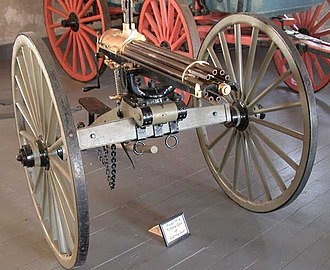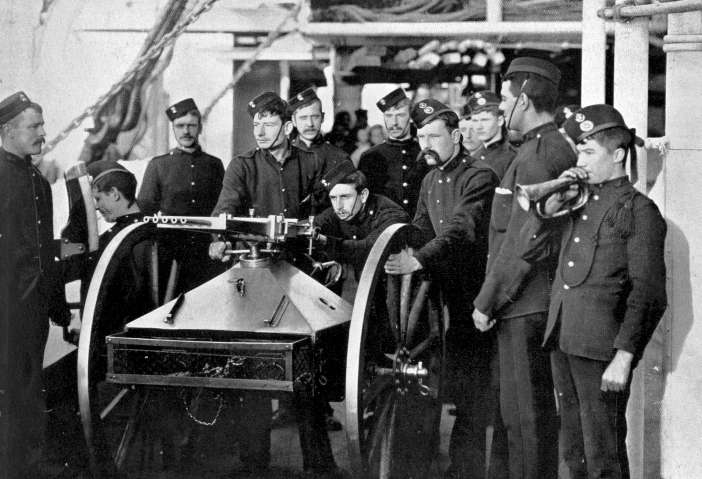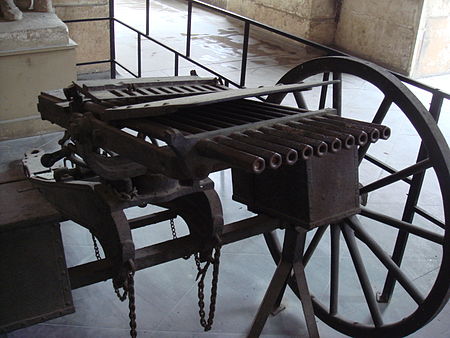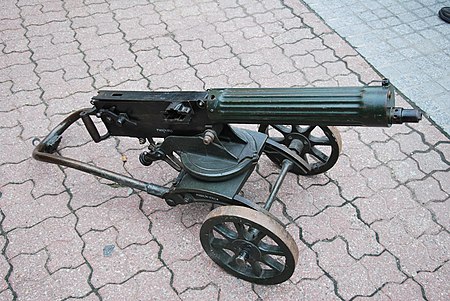The Gatling gun is a rapid-firing multiple-barrel firearm invented in 1861 by Richard Jordan Gatling. It is an early machine gun and a forerunner of the modern electric motor-driven rotary cannon.

The Gatling gun’s operation centered on a cyclic multi-barrel design which facilitated cooling and synchronized the firing-reloading sequence. As the handwheel is cranked, the barrels rotate clockwise and each barrel sequentially loads a single cartridge from a top-mounted magazine, fires off the shot when it reaches a set position (usually at 4 o’clock), then ejects the spent casing out of the left side at the bottom, after which the barrel is empty and allowed to cool until rotated back to the top position and gravity-fed another new round.
The Model 1881 that Gatling switched to the ‘Bruce’-style feed system that accepted two rows of .45-70 cartridges. While one row was being fed into the gun, the other could be reloaded, thus allowing sustained fire. The final gun required four operators. By 1886, the gun was capable of firing more than 400 rounds per minute.
The smallest-caliber gun also had a Broadwell drum feed in place of the curved box of the other guns. The drum, named after L. W. Broadwell, an agent for Gatling’s company, comprised twenty stacks of rounds arranged around a central axis, like the spokes of a wheel, each holding twenty cartridges with the bullet noses oriented toward the central axis. This invention was patented in U. S. As each stack emptied, the drum was manually rotated to bring a new stack into use until all 400 rounds had been fired. A more common variant had 240 rounds in twenty stands of fifteen.
For game purposes, a Gatling gun, operating at full speed, is able to fire 60 bullets in a single combat round (10 seconds) or six bullets per second. Each bullet doing 4d8 damage. If the Gatling gun rolls a hit, 3d20 are rolled to see how many bullets are fired at the individual or target. A save vs Breath Weapon is made. Success reduces the total by half. A Natural 20 means the target dropped flat (if a man or man sized) and all shots missed!

The Gardner gun was an early type of mechanical machine gun. It had one, two or five barrels, was fed from a vertical magazine or hopper and was operated by a crank. When the crank was turned, a feed arm positioned a cartridge in the breech, the bolt closed and the weapon fired. Turning the crank further opened the breechblock and extracted the spent case.

The Gardner machine gun was invented in 1874 by William Gardner of Toledo, Ohio formerly a captain in the Union army during the American Civil War. After producing a prototype he went to the Pratt and Whitney company, who after a year of development produced a military version of the weapon. The standard gun was a 2 barrel affair, and fired both barrels at one turn of the crank. Unlike the Gatling, a safety could be switched, letting live rounds feed through the gun without firing. A feed valve can also be closed off, allowing the clearing of the gun with a full magazine at the ready. The design of the bolts delays unlocking the breech for moments after firing, necessary for hang fires. A cover locked by a quick operating latch can be opened to service the internal parts of the gun.
The Gardner fires a .45 caliber rifle bullet that comes in boxes that, when opened, expose the rims of the bullets. In this way a whole box can be guided down the U-shaped channel of the magazine quickly then pulling the box away. 3 men can keep the gun in continuous operation.
For game purposes, the single barrel Gardner gun fires 40 bullets per Combat Round (10 seconds) or four bullets per second. Each bullet doing 4d8 damage. If the Gardner gun gun rolls a hit, 4d10 are rolled to see how many bullets are fired at the individual or target.
A two barrel Gardner gun fires 70 bullets per Combat Round (10 seconds) or seven bullets per second. Each bullet doing 4d8 damage. If the Gardner gun gun rolls a hit, 4d8x2 are rolled to see how many bullets are fired at the individual or target.
A five barrel Gardner gun fires 110 bullets per Combat Round (10 seconds) or eleven bullets per second. Each bullet doing 4d8 damage. If the Gardner gun gun rolls a hit, (1d10+1)x10 are rolled to see how many bullets are fired at the individual or target.
A save vs Breath Weapon is made. Success reduces the total by half. A Natural 20 means the target dropped flat (if a man or man sized) and all shots missed!

The Nordenfelt gun was a multiple-barrel organ gun that had a row of up to twelve barrels. It was fired by pulling a lever back and forth and ammunition was gravity fed through chutes for each barrel. It was produced in a number of different calibres from rifle up to 25 mm (1 inch). Larger calibres were also used, but for these calibres the design simply permitted rapid manual loading rather than true automatic fire.
The weapon was designed by a Swedish engineer, Helge Palmcrantz. He created a mechanism to load and fire a multiple barreled gun by simply moving a single lever backwards and forwards. It was patented in 1873.
A plant producing the weapon was set up in England, with sales offices in London, and long demonstrations were conducted at several exhibitions. The weapon was adopted by the British Royal Navy, as an addition to their Gatling and Gardner guns.
During a demonstration held at Portsmouth a ten-barrelled version of the weapon, firing rifle calibre cartridges, fired 3,000 rounds of ammunition in 3 minutes and 3 seconds without stoppage or failure.
However, with the development of the Maxim gun the weapon was eventually outclassed. Nordenfelt merged in 1888 with the Maxim Gun Company to become Maxim Nordenfelt Guns and Ammunition Company Limited.
The first quick-firing light gun was the 1-inch Nordenfelt gun, built in Britain from 1880. The gun was expressly designed to defend larger warships against the new small fast-moving torpedo boats in the late 1870s to the early 1880s and was an enlarged version of the successful rifle-calibre Nordenfelt hand-cranked “machine gun” designed by Helge Palmcrantz. The gun fired a solid steel bullet with hardened tip and brass jacket.
For game purposes, the five barrel Nordenfelt gun fires 100 bullets per Combat Round (10 seconds) or ten bullets per second. Each bullet doing 4d8 damage. If the Nordenfelt gun rolls a hit, 1d10x10 are rolled to see how many bullets are fired at the individual or target.
A save vs Breath Weapon is made. Success reduces the total by half. A Natural 20 means the target dropped flat (if a man or man sized) and all shots missed!

The Maxim gun is a recoil-operated machine gun invented by Sir Hiram Stevens Maxim in 1884; the weapon became the first automatic firearm in production by Vickers, which used .303 British ammunition and a recoil-operating firing system, and required water cooling.
Trials demonstrated that the Maxim could fire 600 rounds per minute. Compared to modern machine guns, the Maxim was heavy, bulky, and awkward. A lone soldier could fire the weapon, but it was usually operated by a team of men, usually 4 to 6. Apart from the gunner, other crew were needed to speed reload, spot targets, and carry and ready ammunition and water. Several men were needed to move or mount the heavy weapon.
For game purposes, the Maxim gun fires 100 bullets per Combat Round (10 seconds) or ten bullets per second. Each bullet doing 3d8+2 damage. If the Maxim gun rolls a hit, 1d10x10 are rolled to see how many bullets are fired at the individual or target.
A save vs Breath Weapon is made. Success reduces the total by half. A Natural 20 means the target dropped flat (if a man or man sized) and all shots missed!

The QF 1 pounder, universally known as the pom-pom due to the sound of its discharge, was a 37 mm British autocannon, the first of its type in the world. Hiram Maxim originally designed the Pom-Pom in the late 1880s as an enlarged version of the Maxim machine gun. Its longer range necessitated exploding projectiles to judge range, which in turn dictated a shell weight of at least 400 grams (0.88 lb), as that was the lightest exploding shell allowed under the St. Petersburg Declaration of 1868 Early versions were sold under the Maxim-Nordenfelt label.
For game purposes, the Pom-Pom gun fires 20 shells per Combat Round (10 seconds) or 2 shells per second. . If the Pom-Pom gun rolls a hit, 2d10 are rolled to see how many shells are fired at the individual or target. Unlike a solid bullet, Pom-Pom shells explode with Concussive damage and Shrapnel/shell fragments, expanding outwards from the blast point. It is possible to be injured or killed even if the shell does not score a direct hit (which would be VERY, VERY Bad!)
Radius> | 5’ | 10’ | 15’ | 20’ | 25’ | |
BP Damage | 16hp | 8hp | 4hp | 2hp | 1hp | |
| SH Damage | 6hp | 4hp | 2hp | 1hp | 0hp |
BP = Blast Point Concussive Damage from the blast spreads out evenly in all directions but drops off to nothing around 25 feet from the point of origin. Concussive damage greater then 4hp will require a saving throw to keep from being knocked down. Concussive damage of 8hp or greater WILL knock the character down.
SH = Shrapnel Fragments of the casing fly in all directions but the density of pieces drops off quickly reducing the damage potential to virtually zero after 20 feet from the point of origin.
Damage is CUMULATIVE! Being within five feet of the burst is 22hp of damage IF you Save! A failed saving throw equals DOUBLE DAMAGE = 44hp. NOTE: A roll of 1 on the Saving Throw means that the shell, while it didn’t penetrate you, was virtually in contact with you when it went off and does 88hp damage.
A Direct Hit from the Pom-Pom shell is QUADRUPLE DAMAGE with NO Saving Throw (44×4) = 176hp

A Mitrailleuse is a type of volley gun with barrels of rifle calibre that can fire either all rounds at once or in rapid succession.
The earliest true mitrailleuse was invented in 1851, ten years before the advent of the Gatling gun. It was followed by the Belgian Montigny mitrailleuse in 1863. Then the French 25 barrel “Canon à Balles”, better known as the Reffye mitrailleuse, was adopted in great secrecy in 1866. It became the first rapid-firing weapon deployed as standard equipment by any army in a major conflict
A steel block containing twenty-five 13 mm (.51 calibre) centre-fire cartridges is locked against the breech before firing. With the rotation of a crank, the 25 rounds were discharged in rapid succession. The sustainable firing rate of the Reffye mitrailleuse was 100 rounds per minute and its maximum range was about 2,000 yd
For game purposes, the Reffye mitrailleuse can fire 25 rounds in a single burst, in which case 4d6 are rolled to see how many strike the target. Or, with sustained fire, it discharges 16 bullets per Combat Round (10 seconds) or 1.6 bullets per second. Each bullet doing 6d8+2 damage. If the Reffye mitrailleuse rolls a hit, 2d8 are rolled to see how many bullets are fired at the individual or target.
In either case, a save vs Breath Weapon is made. Success reduces the total by half. A Natural 20 means the target dropped flat (if a man or man sized) and all shots missed!
